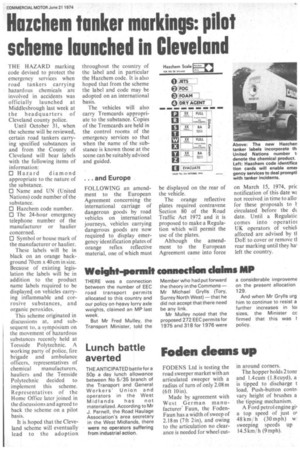Hanhem tanker markings. pilot scheme launched in Cleveland
Page 15

If you've noticed an error in this article please click here to report it so we can fix it.
THE HAZARD marking code devised to protect the emergency services when road tankers carrying hazardous chemicals are involved in accidents was officially launched at Middlesbrough last week at the headquarters of Cleveland county police.
Until October 31, when the scheme will be reviewed, certain road tankers carrying specified substances in and from the County of Cleveland will bear labels with the following items of information: O Hazard diamond appropriate to the nature of the substance.
1:1 Name and UN (United Nations) code number of the substance.
• Hazchem code number.
ID The 24-hour emergency telephone number of the manufacturer or haulier concerned.
O Symbol or house mark of the manufacturer or haulier.
These labels will be in black on an orange background 70cm x 40 cm in size. Because of existing legislation the labels will be in addition to the product name labels required to be displayed, on vehicles carrying inflammable and corrosive substances, and organic peroxides.
This scheme originated in discussions at. and subsequent to, a symposium on the movement of hazardous substances recently held at Teesside Polytechnic. A working party of police, fire brigade and ambulance officers, representatives of chemical manufacturers, hauliers and the Teesside Polytechnic decided to implement this scheme. Representatives of the Home Office later joined in the discussions and agreed to back the scheme on a pilot basis.
It is hoped that the Cleveland scheme will eventually lead to the adoption throughout the country of the label and in particular the Hazchem code. It is also hoped that from the scheme the label and code may be adopted on an international basis.
The vehicles will also carry Tremcards appropriate to the substance. Copies of the Tremcards are held in the control rooms of the emergency services so that when the name of the substance is known those at the scene can be suitably advised and guided.
... and Europe
FOLLOWING an amendment to the European Agreement concerning the international carriage of dangerous goods by road vehicles on international journeys, vehicles carrying dangerous goods are now required to display emergency identification plates of orange reflex reflective material, one of which must be displayed on the rear of the vehicle.
The orange reflective plates required contravene Section 80 of the Road Traffic Act 1972 and it is proposed to make a Regulation which will permit the use of the plates.
Although the amendment to the European Agreement came into force on March 15, 1974, pric notification of this date v./not received in time to allo for these proposals to t circulated before the ch. date. Until a Regulatic comes into operatioi UK operators of vehicl, affected are advised by ti DoE to cover or remove ti rear marking until they ha' left the country.








































































































